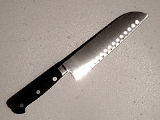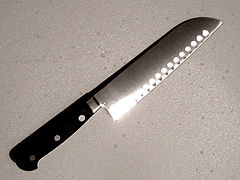
Santoku
Encyclopedia



Kitchen knife
A kitchen knife is any knife that is intended to be used in food preparation. While much of this work can be accomplished with a few general-purpose knives – notably a large chef's knife, a tough cleaver, and a small paring knife – there are also many specialized knives that are designed for...
originating in Japan
Japan
Japan is an island nation in East Asia. Located in the Pacific Ocean, it lies to the east of the Sea of Japan, China, North Korea, South Korea and Russia, stretching from the Sea of Okhotsk in the north to the East China Sea and Taiwan in the south...
. Its blade is typically between 5 and 8 in (12.7 and 20.3 cm) long, and has a flat edge and a sheepsfoot blade that curves in an angle approaching 60 degrees at the point. The top of the santoku's handle is in line with the top of the blade. The word santoku loosely translates as 'three virtues' or 'three uses', a reference to the three cutting tasks the knife performs well: slicing; dicing
Dicing
Dicing is a culinary knife cut in which the food item is cut into small blocks or dice. This may be done for aesthetic reasons or to create uniformly sized pieces to ensure even cooking...
; and mincing
Mincing
Mincing is a food preparation technique in which food ingredients are finely divided. The effect is to create a closely bonded mixture of ingredients and a soft or pasty texture. Flavoring ingredients such as garlic, ginger, and fresh herbs may be minced to distribute flavor more evenly in a mixture...
. The santoku's blade and handle are designed to work in harmony by matching the blade's width/weight to the weight of blade tang and handle, and the original Japanese santoku is considered a well-balanced knife.
Design
Santoku blade geometry incorporates the "Sheep's foot" tip. A sheep's foot design essentially draws the spine ("backstrap") down to the front, with very little clearance above the horizontal cutting plane when the blade is resting naturally from heel to forward cutting edge. Providing a more linear cutting edge, the Santoku has limited "rocking" travel (in comparison to a German/Western-style Chef's knife). The Santoku may be used in a rocking motion, however, very little cutting edge makes contact with the surface due to the extreme radius of the tip and very little "tip travel" occurs due to the short cantilever span from contact landing to tip. An example of this limitation can be demonstrated in dicing an onion - a Western knife generally slices downward and then rocks the tip forward to complete a cut; the santoku relies more on a single downward cut, and even landing from heel to tip, thus using less of a rocking motion than Western style cutlery.The Santoku design is lighter, thinner and shorter than a traditional Western chef's knife. Standard Santoku blade length is between six and seven inches, in comparison to the typical eight inch home cook's knife. Other design departures from classic German/French knives: blade thickness is usually less (thin in comparison) and steel is slightly more hardened (to compensate for the thin cutting edge). Most classic kitchen knives maintain a blade angle between 40 and 45 degrees (a bi-lateral 20 to 22.5 degree shoulder, from cutting edge); Japanese knives typically incorporate a chisel-tip (sharpened on one side), and maintain a more extreme angle (10 to 15 degree shoulder). A classic santoku will incorporate the Western-style, bilateral cutting edge, but maintain a more extreme 12 to 15 degree shoulder, akin to Japanese cutlery. It is critical to increase the hardness of Santoku steel so edge retention is maintained and "rolling" of the thin cutting edge is mitigated. A disadvantage of extremely hard, thin steel is a higher risk of chipping (pushing through a bone or dry herb stock for example). German knives use slightly "softer" steel, but have more material behind their cutting edge. For the average user, a German-style knife is easier to sharpen, but a santoku knife, if used as designed, will hold cutting performance longer between maintenance. With few exceptions, Santoku knives typically have no bolster, sometimes incorporate "scalloped" sides, known as a Granton edge, and maintain a more uniform thickness from spine to blade.
Variations
Some of the best blades employ San Mai laminated steels, including the pattern known as suminagashi (墨流し literally, "flowing-ink paper"). The term refers to the similarity of the pattern formed by the blade's damascened and multi-layer steel alloys to the traditional Japanese art of suminagashi marbled paper. Forged laminated stainless steel cladding is employed on better Japanese santoku knives to improve strength and rust resistance while maintaining a hard edge. Knives possessing these expensive laminated blades are generally considered to be the ultimate expression of quality in a genuine Japanese santoku.Many copies of santoku-pattern knives made outside of Japan have substantially different edge designs, different balance, and softer steels (thus requiring a thicker cutting edge profile) than the original Japanese santoku. One trend in some non-Japanese santoku variations made of a single alloy is to include kullenschliff, scallops or recesses (known as kullens) hollowed out of the side of blade, similar to those found in meat-carving knives. These scallops create small air pockets between the blade and the material being sliced in an attempt to improve separation and reduce cutting friction. However, manufacturing limitations generally restrict such features to mass-produced blades fabricated of softer, less expensive stainless steel alloys.

